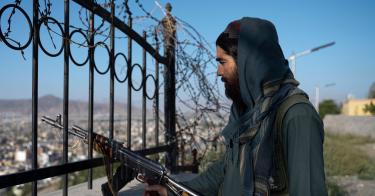Much has changed in Afghanistan since the Biden administration withdrew U.S. forces a year ago. A Human Rights Watch report calls the situation there a “human rights nightmare.”
The group notes that “Taliban authorities have imposed severe restrictions on women’s and girls’ rights, suppressed the media, and arbitrarily detained, tortured, and summarily executed critics and perceived opponents.” More than 90 percent of Afghans are now food insecure.
But the problems go beyond a humanitarian crisis. This month, a U.S. drone strike eliminated notorious Al Qaeda leader Ayman al-Zawahiri. His presence in a Taliban safehouse in Kabul reinforced longstanding concerns about the regime’s enduring links to Al Qaeda.
Afghanistan was always going to be problematic. But did it have to be this bad?
>>> Good Riddance: The Elimination of al-Qaeda’s Top Terrorist and the Troubling Questions It Raises
I have personally been concerned about Afghanistan’s future, and the U.S. mission there, for some time. Years ago, I came to firmly believe in the conclusion of the U.S. director of national intelligence in 2009: “No improvement in Afghanistan is possible without Pakistan taking control of its border areas.”
The U.S. mission in Afghanistan faced many daunting challenges: from flaws in U.S. strategy to quarreling Afghan politicians, corruption, and mismanagement. In terms of impact, however, these paled in comparison to the Taliban’s ace card. So long as Pakistan provided a safe haven for the Taliban’s leadership and a conveyer belt of material and personnel for its rank-and-file, a peaceful and stable Afghanistan would remain hopelessly out of reach, irrespective of progress on the other fronts.
Yet, nothing in the years to follow suggested the U.S. government was prepared to take the difficult but necessary steps to compel Pakistan to end this bloody charade. I became increasingly convinced a “win” in Afghanistan, as originally defined, was unattainable. “Either get serious about Pakistan, or get out,” I cantankerously argued in 2015. Unless “the U.S. is prepared to act like a global superpower and rein Pakistan in, America’s objectives will prove elusive, and U.S. troops will continue making sacrifices on a battlefield where the deck is stacked against them.”
As the U.S. commitment to Afghanistan began to shrink dramatically—from a force of over 100,000 toward a footprint of 2,500—I became more open to the merits of a limited counterterrorism (CT) mission. An Afghan CT mission would be comparatively larger and costlier than the dozens of other CT missions the United States is conducting across the globe, but it would be proximate to a hotbed of some of the world’s most dangerous terrorist groups. It would, however, require the United States to substantially redefine its objectives and have a frank conversation with the Afghan government: “We can’t build this democracy for you, and we can’t protect every village in rural Afghanistan, but we can prevent a complete collapse while we target global terrorists and enemies of the U.S.”
In 2019, with U.S. negotiations with the Taliban underway in Doha, I co-authored a report making a few basic recommendations: 1) A bad deal with the Taliban was worse than no deal; 2) a final decision on a complete U.S. military withdrawal should be contingent on a peace agreement between the Taliban and Afghan government; 3) any withdrawal of U.S. troops should be done in a responsible way; and 4) the United States. should draw a red line around the presence of al Qaeda.
We were under no illusions that staying in Afghanistan was free of risks and costs. And we were cognizant that public support for the Afghanistan mission was, after twenty years of war, waning in the United States. The challenge at the time was to cut through politicized narratives about “forever wars” and ascertain which of the two paths ahead—a complete withdrawal or the maintenance of a limited CT force—would be costlier.
The costs associated with a complete withdrawal appeared more certain and potentially direr. We were far from alone in doubting the Taliban was negotiating in good faith at Doha, or in distrusting the Taliban’s commitment to break ties with Al Qaeda. If anything, there was fairly wide consensus about what was likely to come after a Taliban takeover: an empowered Haqqani Network empowered; dramatic setbacks to political and human rights; economic collapse, and the return of Al Qaeda. Indeed, the Biden administration’s own forecasts seemed to acknowledge a Taliban takeover would follow any U.S. withdrawal. They just substantially overestimated how long the Afghan government would hold out. (Full disclosure: so did I.)
With the benefit of hindsight, would it have been preferable to keep a contingent of 2,500 U.S. soldiers in the country if that meant avoiding this catastrophe? Would it have avoided this catastrophe?
>>> The Tragic Betrayal of Afghan Women a Year After Biden’s Botched Troop Withdrawal
Critics contend the rapid collapse of the Afghan government confirmed the U.S. mission was failing. They further argue the only reason U.S. casualties had fallen dramatically was because the Taliban believed the United States was leaving and wanted to expedite that process. If the United States reversed course, they say, the Taliban would have resumed attacks on American personnel, and casualties would have risen again.
That is plausible. But it’s highly unlikely the Taliban would have marched on Kabul in a matter of weeks. And it’s not a certainty U.S. casualties would have substantially increased. It was U.S. airpower, not ground forces, that had prevented the Taliban from seizing a single provincial capital for twenty years. It is quite possible the United States could have continued having a disproportionate impact on the security environment, acting as a force multiplier and limiting exposure to special raids on high-value targets.
Would a limited but enduring CT mission have been preferable to…this? For the Afghan people, clearly, the answer is yes. What about for the United States? That likely depends on what comes next.
We are beginning to understand the dire economic and human costs of the Taliban takeover. What is not yet clear is how it will impact international terrorism. Zawahiri’s presence in the capital and the empowerment of the Haqqani Network—the most radical and deadly Taliban faction most closely aligned with al Qaeda—have my alarm bells ringing.
This piece originally appeared in the National Interest https://nationalinterest.org/blog/buzz/could-america-have-avoided-tragedy-afghanistan-204438




